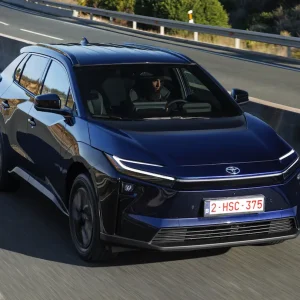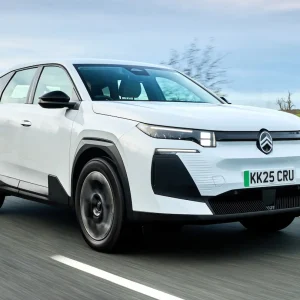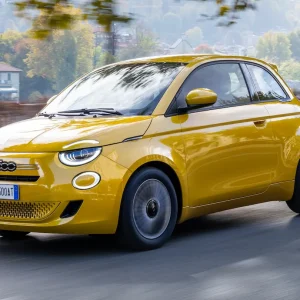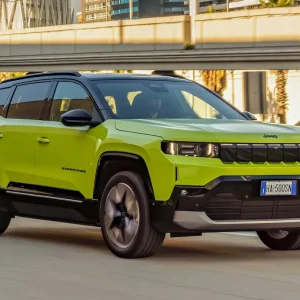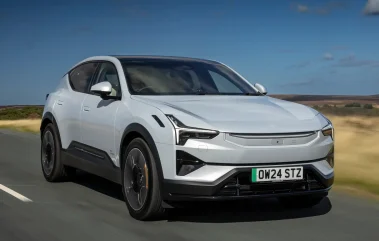
Polestar’s numbering for its models might be going up, with a 5 incoming next year. However, that’s a smaller saloon. So, for now this 3 is as big as Polestar models get – as it shares the Volvo SPA2 platform with the incoming Volvo EX90. So, the Polestar 3 is up against EV rivals such as the BMW iX.
Like the Polestar 4, the 3 gives Polestar the chance to define its own look. The Polestar 3 might be 4.9 metres long, but the defining part of the design must be the lower, more coupe-like roofline – which in our opinion has the effect of making this big SUV look smaller and shorter. Elsewhere, there’s a different take on the split front headlights, unusual wing mirrors, and a distinctive lower cut out down the flanks.
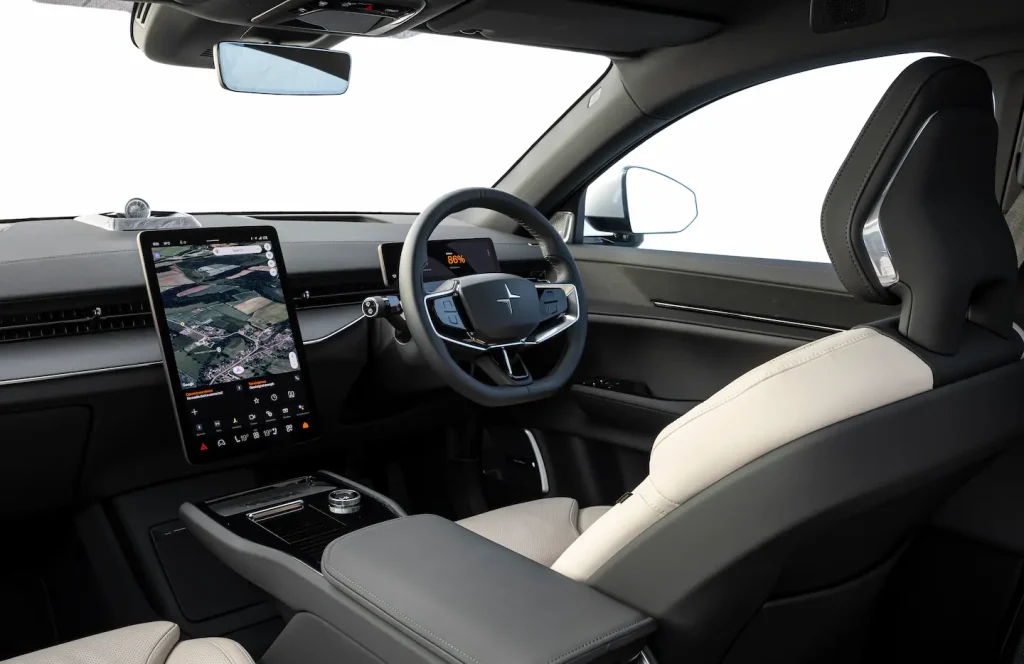
Distinctive on the inside
The Polestar 3 is an attractive and distinctive car on the outside, and it’s the same on the inside. With the lower roofline it doesn’t feel like an SUV, more like a big GT car, and the good news is, headroom front and rear isn’t an issue for the tallest. The driving position is comfortable, and multi-adjustable, the simple horizontal dashboard design is attractive, with the vertical 14.5in infotainment screen (more like the Polestar 2’s), and smaller 9in screen in front of the driver.
Move to the rear, and space remains excellent, although it feels like you’re sitting quite high, with raised knees – like you’re sat on the battery. The panoramic glass roof is an attractive feature, as it lets welcome light into the interior. The fit and finish is special and the Scandic feel echoes what you’d expect of a modern Volvo. So, think quality recycled finishes, leather trim, along with subtle metal detailing. There’s also a generally practical 484-litre boot – although that curvy rear window limits some of its usefulness.
Like the Volvo EX30, we feel the Polestar 3 drivers will be too reliant on the infotainment screen – as too many features in our opinion are within it. We’re sure it would get easier to operate the more time you spend using it, but we found it fiddly and sometimes distracting on our test drive. Elsewhere, the 3 is available with a mega optional Bowers & Wilkins sound system, which boasts 25 speakers and 1,610 watts of power!
The Polestar 3 is also their first car to feature centralised computing with the NVIDIA DRIVE core computer, running software from Volvo Cars. Serving as the AI brain, the NVIDIA platform can process data from the 3’s multiple sensors and cameras to enable driver monitoring and assistance features.
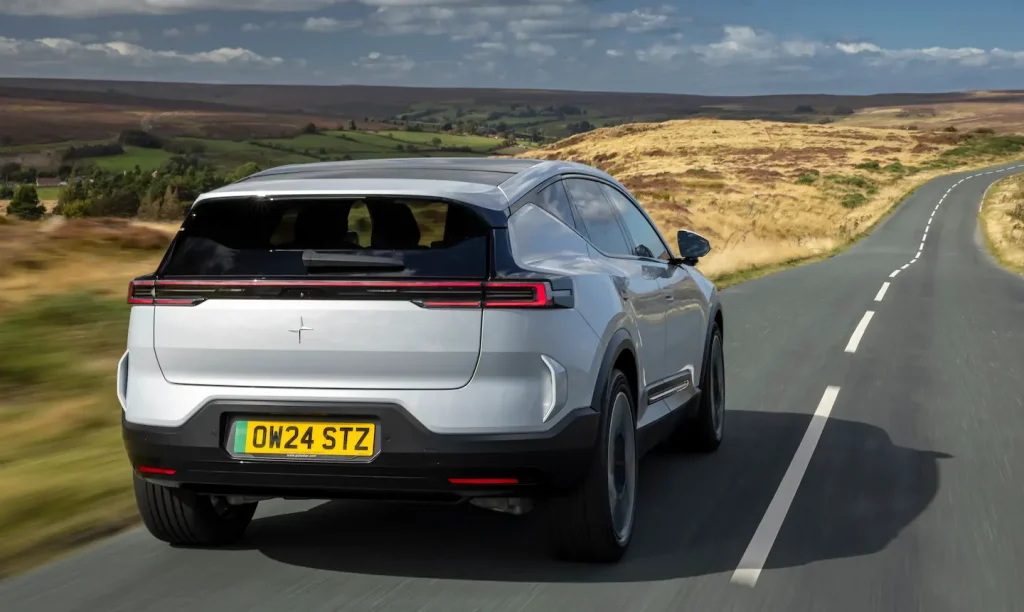
Two twin-motor versions available
Built on Volvo’s SPA2 platform, it has a 111kWh battery pack, 400-volt architecture, and it can be fast charged up to 250kW. There are two versions, both with twin motors, 483hp and Performance pack’s 510hp – with Single Motor Long Range versions due next year. The 483hp version, has 361lb ft of torque, acceleration to 62mph in 7.5 seconds, and most importantly an official range of 380 miles. Apart from the obvious power hike to 510bhp, the Performance pack version’s 0-62mph acceleration drops to just 4.5 seconds, and the range reduced to 279 miles.
On the road, standard air suspension means that despite optional 22in wheels fitted to our Long-Range Dual Motor Launch Edition Car, the ride generally was impressively supple. However, it seemed to struggle more on some of the smaller, less well-kept roads we drove on.
Next up is the steering, which we think has more weight and is sharper in response than the smaller 4, which we drove at the same launch. The Polestar 3 is fitted with a clever, torque vectoring diff. The way this car, which weighs over 2.5 tonnes, turns in and exits corners, plus the body control, is truly impressive. With over 500hp the performance was punchy, too.
We look forward to driving the Single Motor version, which is likely to have the longest range, and as such will be more suitable for fleets. However, the Polestar in range-topping form, is possibly their most impressive model yet, with its unusual styling, attractive and spacious interior, plus the keen drive.
Positive: Impressive drive, unusual and attractive exterior and interior design
Negative: Expensive, some infotainment issues, compromised boot space
Standard equipment: LED headlights, panoramic glass roof, Bio-attributed WeaveTech upholstery, sports comfort front seats, heated front seats, comfort rear seats, three-zone electronic climate control, touch-sensitive multi-function steering wheel, 9in driver display, 14.5 in infotainment screen, 300 watts 10-speaker audio system.
Engines: Electric: 268hp, 536hp
Equipment grades: Long Range Single Motor, Long Range Dual Motor, Long Range Dual Motor with Performance pack
Transmission: Single-speed automatic
| Model | Polestar 3 Long Range Dual Motor 360kW 111kWh |
| P11D | £75,845 |
| Residual value | 48% |
| Depreciation | £38,925 |
| Fuel | £4,647 |
| Service, maintenance and repair | £3,210 |
| Cost per mile | 77.97p |
| Range | 392 miles |
| CO2 (BIK%) | 0g/km (2%) |
| BIK 20/40% a month | £25/£50 |
| Luggage capacity | 484 litres |
| Battery size/power | 111kWh/510hp |
| Score | 8/10 |

